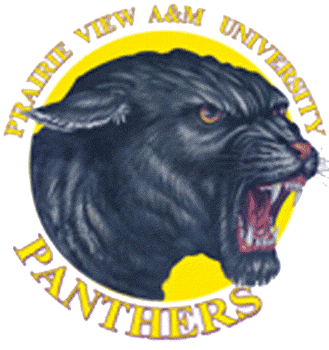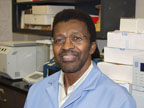Prairie View
From 2007.igem.org
(→Student Profiles) |
(→Project) |
||
| (9 intermediate revisions not shown) | |||
| Line 1: | Line 1: | ||
== 2007 IGEM Team == | == 2007 IGEM Team == | ||
| + | <div align="center">[[Image:Pvamu-large.gif]]</div> | ||
| + | |||
| + | |||
| + | <div align="center">---more pics coming soon---</div> | ||
| + | |||
== Advisors == | == Advisors == | ||
| Line 17: | Line 22: | ||
[[Aziza]] | [[Laina]] | [[Princess]] | [[Sehnaz]] | [[Terry]] | [[Aziza]] | [[Laina]] | [[Princess]] | [[Sehnaz]] | [[Terry]] | ||
| + | |||
== Project == | == Project == | ||
| + | *'''Title''' | ||
| + | ''Development of a Biosensor Device for Detection of Several Metals Simultaneously'' | ||
| + | *'''Abstract''' | ||
| + | |||
| + | Assembling parts for developing microbial biosensors for detection of toxic metals and for organic compounds. | ||
| + | |||
| + | *'''Introduction''' | ||
| + | There exists two essential needs which enabled us to design the trimetallic probe. The need for alternative forms of oil, in fact their methods and the bioremediation of metals ions from the environment. | ||
| + | |||
| + | Micrococcus luteus strain (ATCC 4698) was transformed by plasmid pUC57-S-3M, in which Fe (II), Ni (II) and V (II) were fused to the fluorescence proteins (ECFP, EYFP, and mRFP respectively and to a fluorescent protein coding region [C0061(lux I)] ligated with a signaling sequence BBa_I13207. | ||
| + | |||
| + | The pUC57-S-3M was standardized for its specific sensoribility response to three metal ions and to sulfur (S), in order to detect metal contamination and/or hydrocarbons associated to these metals. Single and combination of the tree metals were used at different concentrations (0.2, 2, 50 ppm). The pUC57-S-3M was grown in the presence and absence of oxygen and/or hydrocarbon (Thiophenol). Only results from combined metals are reported. The biosensoribility was determined by the response of the pUC57-S-3M to the different concentrations of the metals. This response was measured by bioluminescence, fluorescence, DNA concentration, bacterial growth. These parameters were related to sensoribility of the pUC57-S-3M. | ||
| + | |||
| + | *'''Objective''' | ||
| + | |||
| + | Develop and standardize microbial biosensors that respond specifically to toxic metals (nickel, vanadium, iron) simultaneously at different concentrations. | ||
| + | |||
| + | *'''Project Implementation''' | ||
| + | |||
| + | Combine parts such as lux and lacZ gene reporters with inducible promoter and flourescent proteins to develop a microorganism (chasis) with the functions of detecting the toxic metals and or organic compounds. | ||
== Project Planning Journal == | == Project Planning Journal == | ||
| Line 32: | Line 58: | ||
# Assemble new synthesized sequences for iron gene expression and lux genes | # Assemble new synthesized sequences for iron gene expression and lux genes | ||
# Look up the flourescent protein for changes with minimal of three types of proteins | # Look up the flourescent protein for changes with minimal of three types of proteins | ||
| + | |||
== References == | == References == | ||
Latest revision as of 21:53, 30 July 2007
Contents |
2007 IGEM Team
Advisors
Dr Raul Cuero,(PhD)
Dr. Raul Cuero, (PhD), Microbiologist, Distinguished Professor, Research Leader, Scientist and Contact Person for Prairie View A&M University iGEM 2007 group. Dr Cuero holds 8 scientific inventions and more than 90 scientific publications. He is currently working on fungal toxins at the molecular level, and on biogenesis. He is also the author of the book "Triumph and Survival".
Email: olimpa@aol.com
www.raulcuerobiotech.com
Student Profiles
Aziza | Laina | Princess | Sehnaz | Terry
Project
- Title
Development of a Biosensor Device for Detection of Several Metals Simultaneously
- Abstract
Assembling parts for developing microbial biosensors for detection of toxic metals and for organic compounds.
- Introduction
There exists two essential needs which enabled us to design the trimetallic probe. The need for alternative forms of oil, in fact their methods and the bioremediation of metals ions from the environment.
Micrococcus luteus strain (ATCC 4698) was transformed by plasmid pUC57-S-3M, in which Fe (II), Ni (II) and V (II) were fused to the fluorescence proteins (ECFP, EYFP, and mRFP respectively and to a fluorescent protein coding region [C0061(lux I)] ligated with a signaling sequence BBa_I13207.
The pUC57-S-3M was standardized for its specific sensoribility response to three metal ions and to sulfur (S), in order to detect metal contamination and/or hydrocarbons associated to these metals. Single and combination of the tree metals were used at different concentrations (0.2, 2, 50 ppm). The pUC57-S-3M was grown in the presence and absence of oxygen and/or hydrocarbon (Thiophenol). Only results from combined metals are reported. The biosensoribility was determined by the response of the pUC57-S-3M to the different concentrations of the metals. This response was measured by bioluminescence, fluorescence, DNA concentration, bacterial growth. These parameters were related to sensoribility of the pUC57-S-3M.
- Objective
Develop and standardize microbial biosensors that respond specifically to toxic metals (nickel, vanadium, iron) simultaneously at different concentrations.
- Project Implementation
Combine parts such as lux and lacZ gene reporters with inducible promoter and flourescent proteins to develop a microorganism (chasis) with the functions of detecting the toxic metals and or organic compounds.
Project Planning Journal
June
---No entry---
July
- Growth and Genomic DNA Determination of M. luteus
- Growth and Genomic DNA Determination of A. ferroxidons
- Isolation of plasmids from MIT, use of PCR
- Construction of competent cell M. luteus
- Assemble new synthesized sequences for iron gene expression and lux genes
- Look up the flourescent protein for changes with minimal of three types of proteins
References
- Cuero, R, Oullet T. Metal ions modulate gene expression and accumulation of the mycotoxins aflatoxin and zearalenone.J Appl Microbiol. 2005;98(3):598-605.
- Holmes, D.S. Dubey, U.K and Gongolli, 1993. Development of Biosensor for the detection of Mercury andCopper Ions.Environ, Geochem. Health 16: 229-233.
- Leonard G. Davis, Mark D. Dibner, James F Battey. Basic Methods in Molecular Biology. Elsevier Science Publishers.1986, New York, Amsterdam and London.
- Lovley, DR (2003). "Cleaning up with genomics: applying molecular biology to bioremediation". NATURE REVIEWS. MICROBIOLOGY. 1 (1): 35–44. PMID 15040178. Holmes et al 1993b. Holmes D.S et al, 1993. Development of Biosensor to Measure Metal Ions
- Bioavailability in mining and metal waste.pp659-666. In Biohydrometallurgical Technologies. Vol. II. A.E Torma, M.L Apel and C.L Brierle,TMS, Warrendale, PA,USA.Eds.

